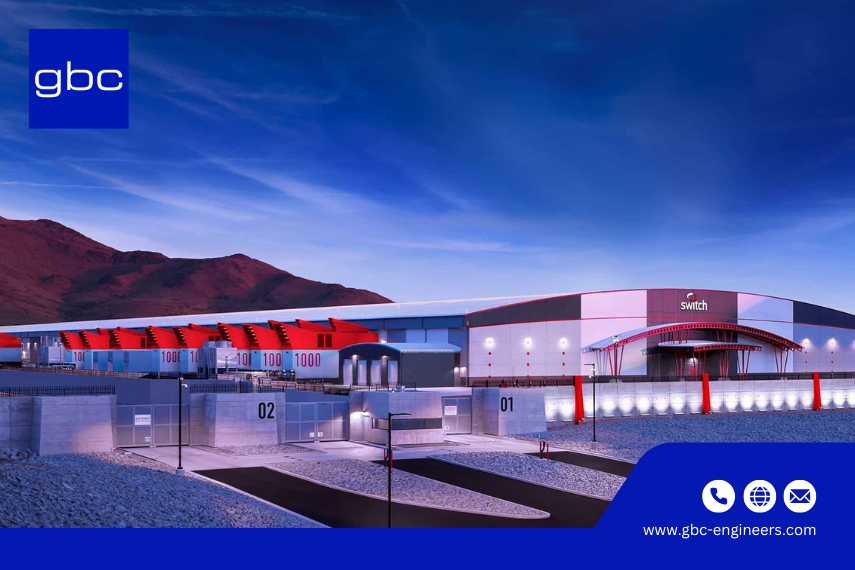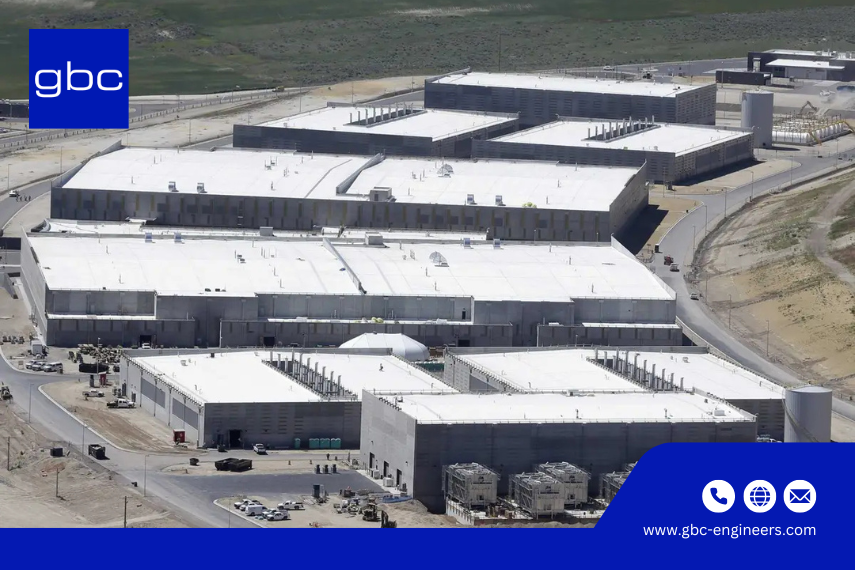As our digital world continues to grow, so does the demand for massive data storage and lightning-fast processing capabilities. From social media and cloud computing to AI and IoT, everything we do online relies on powerful infrastructure hidden inside colossal data centers. In this 2025 edition, we explore the top 5 largest data centers in the world based on size, power capacity, and global impact.
Let's explore with gbc engineers how the largest data center in the world is shaping the future through innovative engineering solutions.
China Telecom-Inner Mongolia Information Park (Hohhot, China)
Location: Hohhot, Inner Mongolia, China
Power Capacity: 150 MW
Area: 994,062 square meters (10.6 million square feet)
Estimated Cost: $3 billion
Operator: China Telecom
China Telecom's Inner Mongolia Information Park stands as the world's largest data center by area. Located in Hohhot, the facility leverages the region's cold climate for natural cooling, enhancing energy efficiency. Designed to accommodate China's growing digital needs, this critical data hub serves a vast array of clients, including national telecom services, and supports colocation services to house multiple clients' IT infrastructure and products.
The facility’s strategic location within China’s network enables it to act as a global data center, playing a central role in managing China’s expansive data requirements across the internet. It supports high volumes of content delivery, cloud processing, and user-generated data that people around the world read, stream, or interact with daily.
With a focus on energy efficiency and cutting-edge technology, the center is a key player in meeting the increasing demand for data storage and processing in the region. This immense data center is not just a home for critical data but a cornerstone in the digital ecosystem supporting the nation's future growth.

The Citadel – Switch (Tahoe Reno, Nevada, USA)
Location: Tahoe Reno, Nevada, USA
Power Capacity: 650 MW
Area: 668,901 square meters (7.2 million square feet)
Estimated Cost: $1.5 billion
Operator: Switch
Switch's Citadel Campus in Nevada is among the largest data centers globally. Powered entirely by renewable energy, it exemplifies sustainable data storage solutions. The facility hosts numerous servers, supporting services from cloud computing to enterprise data needs. Its design emphasizes unmatched access to critical infrastructure and key connectivity, making it a vital hub for businesses across industries, from finance to technology.
The center offers businesses secure, scalable solutions, with a focus on supporting the rapidly growing demand for high-performance processing. Through its exceptional infrastructure, the Citadel ensures reliable and efficient data management, meeting the needs of modern enterprises worldwide.

Yotta NM1 (Panvel, India)
Location: Panvel, India
Power Capacity: 50 MW
Area: 76,180 square meters (820,000 square feet)
Estimated Cost: Over $1.1 billion
Operator: Yotta Infrastructure
Yotta NM1, located in Panvel, India, is a significant player in the data center industry. The facility offers a range of services, including cloud storage, IT support, and data processing. Built to withstand natural disasters, it features advanced power and cooling systems to ensure reliable operations. Yotta NM1 is part of India's broader initiative to establish itself as a global data hub, supporting both local and business clients in need of secure and efficient data management solutions. As India’s digital economy continues to grow, Yotta NM1 plays a critical role in accommodating the expanding demands for high-performance computing and data storage.

Utah Data Center (Bluffdale, Utah, USA)
Location: Bluffdale, Utah, USA
Power Capacity: 65 MW
Area: 130,064 square meters (1.4 million square feet)
Estimated Cost: $1.5 billion
Operator: National Security Agency (NSA)
The Utah Data Center, operated by the NSA, is a pivotal facility for data storage and cybersecurity related to national intelligence in the United States. Designed to handle vast amounts of information securely, it plays a crucial role in managing and processing large datasets, supporting national security initiatives. The center provides cloud services to secure data storage, with an emphasis on maintaining the integrity of sensitive information under strict privacy policies. The facility’s construction integrates advanced security measures and innovative technological capabilities to ensure the safe processing of critical national intelligence. As a cornerstone of U.S. intelligence infrastructure, it ensures that data is stored and accessed with the highest level of confidentiality and security.

Lakeside Technology Center (Chicago, Illinois, USA)
Location: Chicago, Illinois, USA
Power Capacity: 100 MW
Area: 102,193 square meters (1.1 million square feet)
Estimated Cost: Approximately $2 billion
Operator: Digital Realty
Situated in downtown Chicago, the Lakeside Technology Center is one of North America's largest data centers. Managed by Digital Realty, it is renowned for high-speed connectivity and utilizes Lake Michigan for cooling purposes. The facility serves a diverse clientele, including financial institutions, healthcare providers, and tech firms. Its prime location in Chicago's financial district makes it ideal for low-latency services essential for industries reliant on rapid data processing. As a key player in the region's digital infrastructure, it supports businesses in accessing the data solutions they need to stay competitive in a data-driven world. The center also ensures compliance with strict privacy policies, safeguarding sensitive information for its clients and meeting regulatory standards.

Future Trends in Data Centers
Sustainable Data Centers: Reducing Carbon Footprints
As environmental concerns intensify, data centers are adopting innovative strategies to minimize their carbon footprints:
- Real-Time Carbon Footprint Reduction: A multi-agent reinforcement learning framework optimizes data center operations by adjusting cooling, load shifting, and power storage based on real-time weather and grid conditions. This approach has demonstrated a 14.5% reduction in carbon emissions and a 13.7% decrease in power costs.
- Solar-Powered Data Centers: Models integrating solar power with battery storage are being developed to power data centers sustainably. These systems adjust power consumption based on solar availability, enhancing power efficiency.
- Earth-Friendly Computation: Initiatives like "Breathing Life Back into Zombie GPUs" repurpose discarded GPUs to reduce electronic waste. Additionally, GIS-based tools are being used to plan data center placements on Indigenous lands, optimizing for renewable power availability and environmental impact.
Digital Sovereignty and Localized Infrastructure
Geopolitical tensions are prompting a shift towards localized data infrastructure:
- European Cloud Initiatives: Companies like OVHCloud and Iliad are investing heavily in AI and data center infrastructure to reduce reliance on U.S.-based providers. This move aims to bolster digital sovereignty and ensure data privacy.
- Local Energy Utilization: Regions rich in renewable energy sources are becoming hotspots for data center development, aligning energy production with consumption to enhance sustainability.
Source: European firms rethink cloud provider choices amid trade war, OVHCloud CEO says | Reuters
Energy-Efficient Cooling and Power Solutions
Innovations in cooling and power management are crucial for sustainable data center operations:
- Water-Efficient Cooling: Data centers are adopting advanced cooling techniques to minimize water usage. For instance, hyperscale facilities can consume around 365 million gallons of water annually, prompting the development of more efficient systems.
- Natural Gas Utilization: In areas like Southwestern Pennsylvania, data centers are leveraging abundant natural gas resources to meet the growing energy demands of AI-driven operations. However, this raises environmental concerns regarding methane emissions.
Source: AI fuels fracking-powered data centers in Pennsylvania - Axios Pittsburgh
Edge Computing: Decentralizing Data Processing
Edge computing is gaining prominence as data generation moves closer to end-users:
Proximity-Based Processing: By processing data near its source, edge computing reduces latency and bandwidth usage. This is crucial for applications like autonomous vehicles and real-time analytics
Distributed Infrastructure: Smaller, localized data centers are being established to handle specific regional demands, enhancing reliability and speed.
Ready to Future-Proof Your Data Center?
Partner with gbc engineers to design a facility that delivers performance, reliability, and long-term value.
🌐 Visit: www.gbc-engineers.com
🏗️ Explore Our Services: Services - gbc engineers
Conclusion
From China to the U.S. and India, the race to build the largest data center in the world is heating up in 2025. These megastructures are the silent engines of our digital economy, supporting everything from your TikTok feed to national intelligence.
In conclusion, the data center industry is rapidly evolving with new innovations in sustainability, energy efficiency, and technological integration. As one of the leaders in structural engineering and BIM technology, gbc engineers is well-positioned to contribute to the growth of this dynamic sector.
With a focus on high-quality, sustainable designs and cutting-edge solutions, gbc engineers is helping shape the future of data centers worldwide. By staying ahead of industry trends and continually adapting to new challenges, gbc engineers is playing a pivotal role in building the infrastructure that powers the digital world of tomorrow.